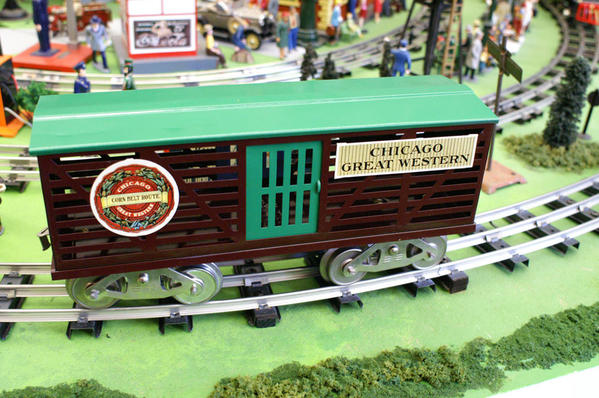Awhile back, I purchased several McCoy cars from a collector who had suffered a fire in his train room that left most of his trains fire and water damaged. You'll see several of these trains in these posts, and the Chicago Great Western car is one of these. The paint was burned off this car and it was very rusty from the water.

I use water-slide decals to decorate the trains I re-do; McCoy almost never used decals (with a few rare exceptions like the Bonner cars), so this helps to avoid any confusion with McCoy originals. I use some commercially-made decals when they work, but usually I make my own: partly because I like to do some off-beat road names, and partly to get the exact size I need. The big drawback of making my own decals is that a home printer cannot print white; and they have a transparent background, so that the car color shows through. What this means in practical terms is that if you put my homemade decals over dark paint, you pretty much can't see them.
McCoy used tinplate placards attached to the cattle car with bent-over tabs, which is perfect for my use: I can paint the car any color I want, and then paint the placards off-white so the decals show up really well.
I'm an Ives fan, and I scanned the graphics for this car directly off my Ives O Gauge 125 herald boxcar.

The decals for the CNR caboose are white, so you can tell I purchased these. I am really pleased with this color combination, I was surprised how well the red and yellow turned out together. I have a small blasting cabinet and I clean all the cars down to bare metal, then prime and paint with rattle-cans, mostly with DeRusto or Valspar because that's what is available locally. I'm not usually trying to match any vintage color, so I don't need to go to Collector's Colors or get paint mixed for these. The rattle-can paint jobs are another thing that clearly distinguishes my work from original McCoy; their paint finish is obviously different, and they used silk-screened graphics.


I wanted to do a covered gondola: not as fancy as MTH's "new tooling" covered gon, this just has a McCoy roof snapped on it, but it's still a different look. The car is more yellow than the pictures show. I originally printed the decals in color but re-printed them all in black: Phoebe Snow aside, this is a gritty coal-route car so I didn't want it to look too fancy.

I want to credit Steve Eastman with getting me started on this project. Steve, when you posted pictures of some of your "beer car" series made from McCoy convention cars, a light bulb went on. Bob McCoy of course did several beer cars of his own, so we're continuing the fine tradition. I haven't done many, but this is one that just had to be done... really Steve, no St. Pauli?
The decals for this took a lot of hours in Photoshop to get right. The Derusto "Meadow Green" for the roof and doors was a very close match.



You're going to see a lot of trains on this thread that are more than just repaints. McCoy made a wide range of car types, but there's some he didn't get to.
This depressed-center flat car is made from two McCoy cars. The first was cut in half and forms the ends and the sloped angles; the other was a flat car with low sides that makes the lower center section. Quite a soldering project, there was a lot of that. This whole thing got really tricky: there are space tolerances that have to be respected. But in the end, the center well does not drag even going over bridges; the wheels turn clear of the frame; and although the car is 16-1/2" long, much longer than a standard McCoy 12" car, it runs just fine on all Standard Gauge track including 42 curves.
I scratch-built the cable drum using a 3" drum sander cylinder for the core and winding some cable around it; and the ends are 1/4" luan cut out with a 4" diameter hole saw. The chains have small springs, hidden where the chains go through inside the drum core, that keep tension on the chains. I thought I might have to glue the reel down or something, but the chains hold it very solid, it doesn't move at all.
This was fun. There are a lot of O Gauge tinplate depressed-center cars, but it's not one that has been done in Standard Gauge, to my knowledge.
david







